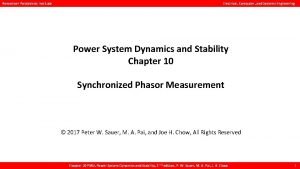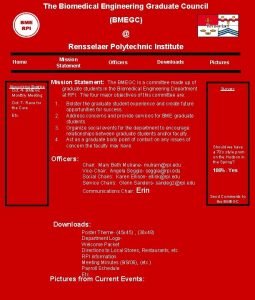Rensselaer Polytechnic Institute Mississippi State University Los Alamos

- Slides: 1

Rensselaer Polytechnic Institute Mississippi State University Los Alamos National Laboratory Florida State University Stochastic Growth in a Small World and Applications to Scalable Parallel Discrete-Event Simulations H. Guclu 1, B. Kozma 1, G. Korniss 1, M. A. Novotny 2, Z. Toroczkai 3, P. A. Rikvold 4 1 Department of Physics, Applied Physics, and Astronomy, Rensselaer Polytechnic Institute, 110 8 th Street, Troy, NY, 12180 -3590, U. S. A. 2 Department of Physics and Astronomy, and Engineering Research Center, Mississippi State University, P. O. Box 5167, Mississippi State, MS, 39762 -5167, U. S. A. 3 Complex Systems Group, Theoretical Division, Los Alamos National Laboratory, MS B-213 Los Alamos, NM 87545, U. S. A. 4 Department of Physics, Center for Materials Research and Technology and School of Computational Science and Information Technology, Florida State University, Tallahassee, FL 32306 U. S. A. Simulating the Parallel Simulations Abstract v. Universality/roughness (d=1) We consider a simple stochastic growth model on a small-world network. The same process on a regular lattice exhibits kinetic roughening governed by the Kardar-Parisi-Zhang equation. In contrast, when the interaction topology is extended to include a finite number of random links for each site, the surface becomes macroscopically smooth. The correlation length of the surface fluctuations becomes finite and the surface grows in a mean-field fashion. Our finding provides a possible way to establish control without global intervention in non-frustrated agent-based systems. A recent application is the construction of a fully scalable algorithm for parallel discrete-event simulation. (Foltin et. al. , 1994) G. K. et al. , Science 299, 677 (2003) Roughness (Width) exact KPZ: =1/3 =1/2 Phase transitions in Small-World (SW) Networks Utilization Trade-off/Scalable Data Management G. K. et al. , PRL 84, 1351 (2000) § Watts&Strogatz (1998): “… enhanced signal-propagation speed, computational power, and synchronizability”. § Finite number of random links per site (average connectivity is not extensive) § Phase transition or phase ordering is possible even when random links are added to an originally one-dimensional substrate: § Barrat&Weight (2000), Gitterman (2000), Kim et al. (2001): Ising model on SW network § Hong et al. (2002): XY-model and Kuramoto oscillators on SW network. § These systems exhibit a phase transition of mean-field kind. Utilization (Efficiency) EW Model on a Small-World Network Finite-size effects for the density of local minima/average growth rate (steady state): (d=1) eigenvalues of ij Synchronization in Parallel Discrete-Event Simulations for a single realization of the random network Parallelization for asynchronous dynamics Paradoxical task: § (algorithmically) parallelize (physically) non-parallel dynamics N sites only nn. interactions Difficulties: § Discrete events (updates) are not synchronized by a global clock §Traditional algorithms appear inherently serial (e. g. , Glauber attempt one site/spin update at a time) Implications for Scalability Simulation reaches steady state for (arbitrary d) However, these algorithms are not inherently serial (Lubachevsky, 1987) nn. + regular LR interactions (of range N/2) v. Simulation phase: scalable with sh. p. b. c: u ∞ asymptotic average growth rate (simulation speed or utilization ) is non-zero (Krug and Meakin, 1990) Two Approaches for Synchronization i Speedup (utilization NPE ) Utilization (fraction of non-idling PEs) d=1 nn. + quenched random links v. Measurement (data management) phase: not scalable measurement at meas: (e. g. , simple averages) (site index) i Roughness And the Density of States v. Optimistic (or speculative) § PEs assume no causality violations § Rollbacks to previous states once causality violation is found (extensive state saving or reverse simulation) § Rollbacks can cascade (“avalanches”) Synchronization/Time-Horizon Control Via Small. World Communication Network Design v. Conservative § PE “idles” if causality is not guaranteed § Utilization, u : fraction of non-idling PEs small-world-like connections: (used with probability p>0) disorder average Basic Conservative Approach • one-site-per PE, NPE=Ld • t=0, 1, 2, … parallel steps • i(t) local simulated time • local time increments are iid exponential random variables • advance only if (nn: nearest neighbors) density of eigenvalues § p=0: ( ) 1/ for 0 integral and [ w 2 ] diverges § sufficiently fast vanishing ( ) as 0 finite [ w 2 ] Monasson, EPJB 12, 555 (1999) for diffusion on SWN (steady-state structure factor) Exact numerical diagonalization of ij and comparison with the results for the simple massive coupling matrix v. Scalability modeling §utilization (efficiency) u(t) (fraction of non-idling PEs) density of local minima §width (spread) of time surface: Acknowledgment References and Contact We thank B. D. Lubachevsky, G. Istrate, Z. Rácz and G. Györgyi for discussions. We acknowledge the financial support of NSF through DMR 0113049 and DMR-9981815, the Research Corporation through RI 0761, and (Z. T. ) DOE through W-7405 -ENG-36. [1] G. Korniss, Z. Toroczkai, M. A. Novotny, and P. A. Rikvold, Phys. Rev. Lett. , 84, 1351 (2000). [2] G. Korniss, M. A. Novotny, H. Guclu, Z. Toroczkai, and P. A. Rikvold, Science, 299, 677 (2003). Contact: korniss@rpi. edu, http: //www. rpi. edu/~korniss Summary • Synchronizability of large non-frustrated agent-based systems with SW Network: application to construct fully scalable parallel simulations without global synchronizations • Spectrum exhibits pseudo-gap or possibly a gap, yielding a finite width for stochastic growth on a small-world network for all p>0 • Possible flat-rough transition if range of random links is not uniformly distributed, but instead a power law

